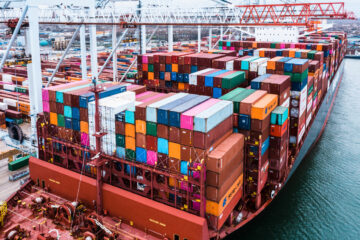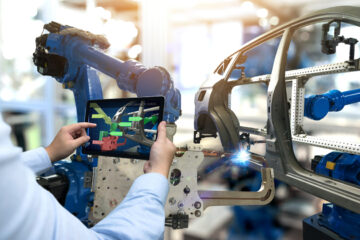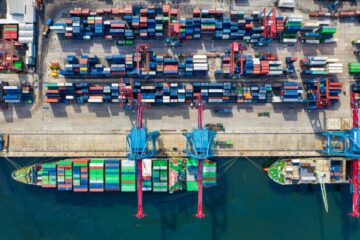
Looking back at the trials and tribulations that faced the supply chain in 2022, the biggest obstacle proved to be operating in a world changed by the global pandemic. Many of the world’s leading economies have found way to adapt but with a resurgence of cases in China, the leading country in manufacturing consumer goods, the threat has set to be subsided. 2023 will see a continuation of trends started in 2022, however at a more accelerated rate. Here are my predictions for supply chain trends in 2023:
Robotics
Warehouses are becoming completely automated, examples like Amazon releasing their first intelligent robotic system ‘Sparrow’ helps to streamlines their fulfillment process. Sparrow represents a major advancement in the state-of-the-art technology of industrial robotics, of which Amazon is front and center in this field. With a blend of AI and computer vision, Sparrow can optimize their supply chain at an increased efficiency.
The change of warehouses and factories adapting to automated robotics, is a result of the rise in online sales due to the pandemic. E-commerce sales for 2022 recorded to be 19.7% of the total retail sales worldwide. Furthermore, the percentage is forecasted to increase to 24% by 2026. To keep up with this demand, especially since there’s been labor shortages and the risk that the pandemic brought with outsourcing labor to other countries, companies are now investing in robotics to optimize their supply chain in 2023.
Artificial Intelligence (AI) and Machine learning
It’s said that 2023 will be the learning curve for AI, with adaptation in the supply chain increasing year-on-year. Technological advancement has boosted the wide use of AI and machine learning in different industries. Uses of AI and machine learning: Aid businesses in automating decision-making and customer service, optimize and automate inventory flow to keep your business running smoothly with little to no human involvement.
Adoption also aids businesses to create better quality products, AI also gives a new perspective in the manufacturing of said products. This initiative will be used by BMW as they stated, all vehicle plants will be digitalized using 3D laser scanning by early 2023. The aim is to make a virtual simulation of all the steps of planning and production of their supply chain. Virtualization takes planning for all processes to a new level, by enabling collaboration in real time between different locations and across different time zones.
Electronic Vehicles (EVs) used in Logistics
There are already examples of companies realizing the potential of EVs in logistics, especially the delivery of goods. Amazon planned rollout of over 1,000 Rivian Electric Delivery Vehicles (EDVs) which debut in the biggest U.S. cities. As of December 15, 2022, Walmart drone delivery is available in select markets in Texas, Arizona and Florida. Many customers in the Orlando, Phoenix, and Dallas areas can take advantage of same-day delivery via drone. Optimizing the ‘last mile’ from using petrol-powered vehicles proves to me the importance companies put on their corporate social responsibility (CSR), as many pledge to lower their carbon emissions, this is a way to achieve that goal.
Increased usage of alternative fuels
Currently, most container ships run on fossil fuels, in spite of that at COP26 Glasgow 2019, the Clydebank Declaration was signed. It was agreed to establish at least six green shipping corridors by 2026. A Green shipping corridor is an area within a shipping route between two or more ports, where zero-emission fuels and technologies, can be adopted to reduce greenhouse gas emissions. The alternative fuels that show the most promise of adaptation are Methanol and Green Hydrogen.
Back in 2021, shipping giant Maersk pledged it would operate a “carbon-neutral” vessel by 2023, investing 1.4 billion on ships that can run on methanol. Morten Bo Christiansen, Maersk’s head of decarbonization, said the vessels would “hit the waters from late 2023.” He added: “Once they are all out there sailing on green methanol, they will save a million tons of CO2 every year.” As of October 2022, Maersk ordered six more vessels fueled by carbon neutral methanol. 2023 will be an important year for the shipping industry.
ESG Compliance
Governments are increasing their demands for companies to prove that they operate sustainably and ethically. In January 2023, Germany’s new Supply Chain Act (Lieferkettengesetz) will come into effect, requiring businesses to demonstrate environmental, social and corporate governance (ESG) transparency in their supply chain. If not adhered to, German companies now face fines of up to 2% of their global turnover.
This is a domestic law, however it may have international significance. Germany is one of the best performing economies in the EU, this move may influence other EU nations to adopt similar laws, hence beginning the trend.
Final thoughts
2023, I predict will follow similar trends to 2022, as the world sees itself in a similar predicament following the pandemic. Nevertheless, I see an importance placed on sustainability and companies wanting to lower their carbon footprint where possible in their supply chain. COP27 was dubbed the ‘implementation’ COP, many governments and business are now making a serious effort to tackle climate change. Consumer habits and societal norms are changing, the supply chain will now look to adapt with time.
- SEO Powered Content & PR Distribution. Get Amplified Today.
- Platoblockchain. Web3 Metaverse Intelligence. Knowledge Amplified. Access Here.
- Source: https://www.allthingssupplychain.com/all-things-supply-chain-top-5-supply-chain-trends-for-2023/?utm_source=rss&utm_medium=rss&utm_campaign=all-things-supply-chain-top-5-supply-chain-trends-for-2023
- 000
- 1
- 2%
- 2019
- 2021
- 2022
- 2023
- a
- accelerated
- Achieve
- across
- adapt
- added
- adopt
- adopted
- ADvantage
- AI
- Aid
- aids
- All
- already
- alternative
- Amazon
- and
- AREA
- areas
- arizona
- automate
- Automated
- automating
- available
- back
- becoming
- Beginning
- BEST
- Better
- between
- Biggest
- Billion
- Blend
- BMW
- Bo
- Boosted
- brought
- business
- businesses
- carbon
- carbon emissions
- carbon footprint
- cases
- Center
- chain
- change
- changing
- China
- Cities
- Climate
- Climate change
- co2
- collaboration
- come
- Companies
- completely
- computer
- Computer Vision
- consumer
- Container
- continuation
- Corporate
- corporate governance
- Corporate Social Responsibility
- countries
- country
- create
- curve
- customer
- Customer Service
- Customers
- Dallas
- decarbonization
- December
- Decision Making
- delivery
- Demand
- demands
- demonstrate
- different
- Domestic
- drone
- dubbed
- e-commerce
- Early
- economies
- effect
- efficiency
- effort
- Electric
- Emissions
- enabling
- environmental
- ESG
- especially
- establish
- EU
- examples
- Face
- faced
- factories
- field
- fines
- First
- florida
- flow
- follow
- following
- Footprint
- fossil fuels
- found
- from
- front
- fulfillment
- Furthermore
- GAS
- German
- Germany
- giant
- gives
- Global
- global pandemic
- goal
- goods
- governance
- Governments
- Green
- greenhouse gas
- Greenhouse gas emissions
- head
- helps
- here
- However
- HTTPS
- human
- hydrogen
- importance
- important
- in
- Increase
- increased
- increasing
- industrial
- industries
- industry
- influence
- Initiative
- Intelligence
- Intelligent
- International
- inventory
- investing
- involvement
- IT
- itself
- January
- Keep
- labor
- laser
- Late
- Law
- Laws
- leading
- learning
- Level
- little
- locations
- logistics
- Look
- machine
- machine learning
- Maersk
- major
- make
- Making
- manufacturing
- many
- Markets
- Methanol
- million
- more
- most
- move
- Nations
- Neutral
- Nevertheless
- New
- obstacle
- october
- ONE
- online
- online sales
- operate
- operating
- Optimize
- optimizing
- Orlando
- Other
- Outsourcing
- pandemic
- percentage
- performing
- perspective
- phoenix
- planned
- planning
- plants
- plato
- Plato Data Intelligence
- PlatoData
- ports
- possible
- potential
- predict
- Predictions
- press
- process
- processes
- Production
- Products
- promise
- Prove
- proved
- proves
- put
- quality
- Rate
- real
- real-time
- realizing
- recorded
- reduce
- represents
- responsibility
- result
- retail
- Retail Sales
- Rise
- Risk
- rivian
- robotics
- Route
- Run
- running
- Said
- sailing
- sales
- Save
- scanning
- sees
- serious
- service
- set
- Shipping
- ships
- shortages
- show
- signed
- significance
- similar
- simulation
- since
- SIX
- smoothly
- Social
- societal
- sparrow
- Spite
- started
- state-of-the-art
- stated
- Steps
- subsided
- supply
- supply chain
- Supply Chain Trends
- Sustainability
- system
- Take
- takes
- technological
- Technologies
- Technology
- texas
- The
- the world
- their
- things
- threat
- time
- to
- tons
- top
- top 5
- Total
- Transparency
- Trend
- Trends
- trials
- turnover
- u.s.
- Usage
- use
- vehicle
- Vehicles
- Vessel
- via
- Virtual
- vision
- Walmart
- wanting
- which
- wide
- will
- within
- world
- world’s
- worldwide
- would
- year
- Your
- zephyrnet
- zones










